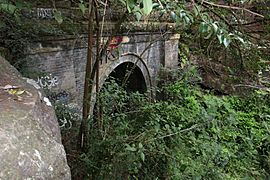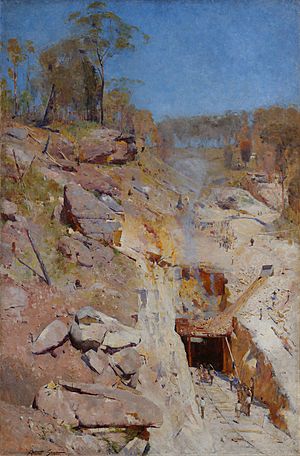Glenbrook Tunnel (1892) facts for kids
 |
|
| Entrance to the 1892 Glenbrook Tunnel | |
| Overview | |
|---|---|
| Line | Main Western Line (since deviated) |
| Location | Glenbrook |
| Coordinates | 33°45′54″S 150°37′56″E / 33.7651°S 150.6323°E |
| Status | Abandoned |
| System | Heavy rail |
| Start | Tunnel Gully Reserve (east) 33°46′04″S 150°38′06″E / 33.76777°S 150.63509°E |
| End | Mushroom Farm (west) 33°45′49″S 150°37′48″E / 33.763581°S 150.629925°E |
| Operation | |
| Work begun | April 1891 |
| Closed | 1913 |
| Owner |
|
| Character | Passenger |
| Technical | |
| Design engineer | NSW Government Railways |
| Length | 634 metres; 693 yards (31.5 chains) |
| No. of tracks | Single (since removed) |
| Gauge | 4 ft 8 1⁄2 in (1,435 mm) standard gauge |
| Grade | 1:33 |
The Glenbrook Tunnel is a special place in Glenbrook, Australia. It started as a railway tunnel for trains, then became a secret storage spot for mustard gas during World War II. Today, it's used as a mushroom farm!
This tunnel is part of the New South Wales State Heritage Register, meaning it's an important historical site. It was built between 1891 and 1892 by the Department of Railways. The tunnel is also known as the Lapstone Hill tunnel. It's about 633 meters (2,077 feet) long and has a tricky S-shape with a steep slope.
The Glenbrook Tunnel opened on December 18, 1892. However, it had problems: the steep slope made it hard for trains, water dripped inside making the tracks slippery, and there wasn't enough fresh air. Trains often got stuck inside! Because of these issues, a new railway route was planned. The tunnel closed to trains on September 25, 1913.
After the railway closed, the tunnel was used to grow mushrooms. But in 1942, during World War II, the Royal Australian Air Force (RAAF) used it to store mustard gas. This was done in case Japan attacked Australia with chemical weapons. The RAAF left after the war, and the tunnel went back to being a mushroom farm.
Contents
History of the Glenbrook Tunnel
From Railway to Mushroom Farm
The first railway line in this area opened in 1867. It climbed the steep Blue Mountains using a special track called the Lapstone Zig Zag. As more trains used the line, it became very busy. So, in 1891, a new tunnel was planned to bypass the Zig Zag.
Building the tunnel was a big job. George Proudfoot was the contractor, and his workers lived in camps nearby. A famous Australian artist, Sir Arthur Streeton, painted a picture called 'Fire's On!' in 1891. This painting shows a fire in the tunnel and a sad accident that happened during its construction.
The new tunnel opened on December 18, 1892. But it wasn't very successful. The steep slope and smoky air made train journeys difficult. Water dripping from the roof also made the tracks slippery, causing trains to struggle.
Because of these problems, a new railway route was built. This new route included a large bridge over Knapsack Gully and a new tunnel. The Glenbrook Tunnel was last used by trains on September 25, 1913. After that, the railway tracks inside were removed, and the tunnel was left quiet.
Around 1913, a man named Herbert Edward Rowe leased the tunnel. He had the idea to grow mushrooms inside. The tunnel's cool, dark, and damp conditions were perfect for mushrooms. The Rowe family lived nearby and used most of the tunnel for their mushroom beds.
A Secret War Storage Site
In 1930, Australia agreed to the 1925 Geneva Protocol. This international agreement banned the use of poisonous gases in war for attacking others. This was because of the terrible experiences with chemical weapons during World War I. Many Australian soldiers suffered from gas attacks, and their injuries were clear to see when they returned home.
However, the protocol allowed countries to use chemical weapons if they were attacked first.
The Tunnel's Role in World War II
By 1937, Australia started thinking about needing gas for defense. In early 1942, during World War II, Japan's advance in Asia made Australia worry about a possible invasion. There was concern that Japan might use chemical weapons, as they had in China.
Australia asked Britain for chemical warfare supplies, which arrived quickly in May 1942. Later, more supplies came from the United States. Australia ended up with almost a million chemical weapons, including different types of mustard gas.
The first chemical weapons for the RAAF were stored in the Blue Mountains. Tunnels were chosen because they had steady temperatures and humidity, similar to caves. This protected the chemicals. Australia did not make these chemicals on a large scale.
The Glenbrook Tunnel was one of fifteen main chemical storage sites in Australia. Only four of these used tunnels for storage: Marrangaroo, Glenbrook, Clarence, and Picton. These four tunnels formed the main storage area for the Royal Australian Air Force's No. 1 Central Reserve. Their hidden locations protected them from air attacks.
On January 6, 1942, the RAAF decided to use the Glenbrook Tunnel to store bombs. By August 1942, it was mainly used for mustard gas. The RAAF filled the tunnel with thousands of tonnes of mustard gas containers. They also set up an area near the tunnel entrance for maintenance and safety.
In 1943-1944, more gas arrived, so the Clarence Tunnel was also used. By February 1944, chemical weapons were moved from Glenbrook to Clarence. Later, the RAAF decided to move most chemical weapons to areas closer to where they might be needed.
After the war ended in 1946, Australia had to figure out how to get rid of the chemical weapons. They tried different ways, and burning was found to be best for mustard gas. Large amounts of gas were burned in the Newnes State Forest in 1946. More cleanup happened until 1980 to make sure the area was safe.
The Glenbrook Tunnel was considered a better place to work by the RAAF staff compared to other depots. The workers had to wear special gear to handle the gas. Their work at Glenbrook was kept secret for a long time.
Inside, the S-shaped tunnel was dark, even with lights. It was packed with containers of chemicals. The tunnel was narrow, making it hard for trucks to move around. The ends of the tunnel were built with brick and stone. During the war, the RAAF added a concrete floor and a telephone system for security.
What the Tunnel is Used for Now
After World War II, the Glenbrook Tunnel went back to growing mushrooms. In 1992, the people leasing the tunnel started growing special types of mushrooms. Other tunnels not used for gas storage also became mushroom farms.
The Glenbrook Tunnel is now abandoned for mushroom growing. The Marrangaroo tunnel is also abandoned. The Clarence tunnel is part of a tourist railway, and the Picton tunnel is a tourist attraction. The secret history of the Glenbrook Tunnel's use during World War II was not widely known until the early 2000s.
Tunnel Features and Design
The Glenbrook Tunnel is shaped like an 'S' curve. It's built with bricks inside, and some parts have a cement finish. It's about 660 meters (2,165 feet) long. The western entrance is close to Knapsack Reserve, and the eastern end is near Railway Reserve.
The western entrance has a large brick arch with sandstone details. The opening is now covered with iron sheets, an exhaust fan, and a roller door. These are used to secure and ventilate the tunnel for its current use. The eastern entrance looks similar.
Inside, you can see both painted and unpainted brick walls and roof. The floor is concrete, which replaced the old railway tracks. There are small holes in the walls for drainage. Pipes and racks for the mushroom farm are visible. Lights run down the center of the tunnel. The floor slopes upwards from east to west.
Along both sides of the tunnel, there are small, recessed areas called "refuges." These were safe spots for railway workers if a train came through. They are about 686 mm (27 inches) deep, 1.2 meters (4 feet) wide, and 1.98 meters (6.5 feet) high.
Tunnel Condition
The tunnel structure looks to be in very good shape. The mushroom racks and other equipment inside are not part of the main structure and could be removed easily.
The tunnel hasn't been changed much structurally. The biggest changes are the concrete floor replacing the railway tracks and the removal of the mustard gas storage equipment.
Why the Tunnel is Important
The Glenbrook Tunnel is very important because it shows Australia's secret plan to store chemical weapons during World War II. It was one of only four tunnels in New South Wales used for this purpose. This shows how Australia prepared for a possible attack by Japan.
The tunnel also reminds us of a hidden part of Australian military history that wasn't known publicly until recently. Many people who worked with the gas couldn't talk about their experiences for years.
Locally, the tunnel is important because it was built to improve the railway line by bypassing the difficult Lapstone Zig Zag. For the 20 years it was used, it was known for its unpleasant, smoky conditions for train crews and passengers.
The tunnel is also famous because it was painted by Sir Arthur Streeton in his well-known artwork 'Fire's On!'. This makes the site important to Australian art history.
The Glenbrook Tunnel is also special to the Defence Force Armourers and their families. It proves the long-hidden story of their work during World War II.
It's rare because it's one of only four tunnels in New South Wales used for chemical gas storage during World War II. Also, it's the only one of these tunnels that went back to its original post-railway use of mushroom growing.
The tunnel is a great example of railway engineering from the late 1800s. It shows how tunnels were built to handle more train traffic.
Images for kids





